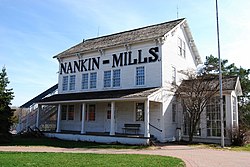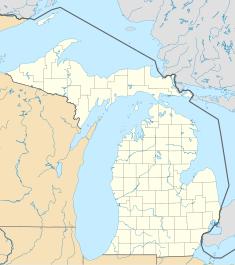History
Construction on the first mill on this site was begun in 1835. However, the construction was abandoned until 1842, when a new owner completed the building and installed an overshot water wheel. [2] A small community, known as Pike's Peak, grew up around the mill. In addition to the mill, Pike's Peak boasted a blacksmith's shop, printing shop, general store, and post office. [3]
The original mill burned some time during the Civil War. The present mill was constructed in 1863 by Samuel Hardenbergh. In 1887, Hardenbergh sold the mill to Isaac Martin Lewis, who replaced the overshot water wheel with a more efficient turbine. [2]
In 1918, Henry Ford purchased the mill as part of his Village industries program. Ford developed his Village Industries in part to provide farm workers a stable source of income during the winter months. [4] He converted the building into a small factory, and in 1920, twelve [5] workers began producing screws for Ford. [2] It was the second Village Industry to open, after the Ford Valve Plant in Northville. [5] In 1927, Ford converted the site to make engravings and stencils; eventually it employed 70 people. [5]
However, the Village Industries experiment proved unprofitable, and after World War II the factory closed. [1] In 1948, Ford donated the site to the Wayne County Road Commission. [2] The commission remodeled the mill, and in 1956 it was opened as a nature center. [1] In the mid-1980s, Nankin Mills became the headquarters of the Wayne County Park System. [2] An addition was built in 1999, and in 2001 the original mill reopened as an interpretive center. [2]
This page is based on this
Wikipedia article Text is available under the
CC BY-SA 4.0 license; additional terms may apply.
Images, videos and audio are available under their respective licenses.




